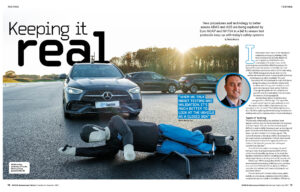Industry News
FEATURE: NHTSA and Euro NCAP look to update test procedures and technologies
New procedures and technology to better assess ADAS and ADS are being explored by Euro NCAP and NHTSA in a bid to ensure test protocols keep up with today’s safety systems, discovers Trinity Francis, in an exclusive feature first published in the September 2024 issue of ADAS & Autonomous Vehicle International magazine.
In the 10 years since Euro NCAP introduced autonomous emergency braking (AEB), lane-keeping assist and lane-departure warning testing, ADAS has become commonplace in modern cars. As the technology has evolved, Euro NCAP has adapted its framework to include separate vulnerable road user (VRU) and safety-assist scores within its five-star rating.
MIPS introduces P8700 AI-enabled RISC-V CPU for ADAS and AV
MIPS has launched the MIPS P8700 Series RISC-V processor, which is designed to meet the low-latency, highly intensive data movement demands of ADAS and autonomous vehicles (AVs).
The P8700 delivers accelerated compute, power efficiency and scalability. Usual solutions for ADAS and AVs rely on embedding a higher number of cores at higher clock rates. The P8700 uses multithreaded and power-efficient architecture that allows customers to implement fewer CPU cores and lower thermal design power (TDP) than competitor products.
This allows OEMs to develop ADAS solutions in an affordable and highly scalable manner. It also mitigates the bottlenecks of data movement inefficiency by providing efficient and lower power-latency-sensitive solutions tailored for interrupt-laden multisensor platforms.
Wipro and Forvia transform ADAS applications
Forvia is using Wipro’s edge cloud building blocks, namely microservices and vehicle container architecture components, to enhance its vehicle safety and comfort applications.
Forvia’s ADAS applications are mostly independent of hardware, lower in maintenance costs and continuously integrated into OEM value chains thanks to the underlying cloud-native architecture. The project with Wipro involved Forvia’s innovative surround-view technology, which combines exterior camera views into an immersive 3D perspective that helps drivers park their vehicles safely and easily.
All functions of Forvia’s ADAS applications set have now been brought into a loosely connected, service-oriented microservice architecture. This update has led to significantly lower software development lifecycle (SDLC) costs.
Zoox robotaxi starts operations in San Francisco
Zoox has rolled out its robotaxi on the streets of San Francisco and expanded its Las Vegas geofence, significantly expanding operations in California and Nevada.
The company’s CEO, Aicha Evans, said, “Since 2017, our test fleet has autonomously navigated San Francisco streets with a safety driver. Now that we’ve passed all critical safety measures, we are excited to begin testing our robotaxi in this wonderful city.”
Initial testing for the robotaxi will occur in a focused area, particularly the SoMa neighborhood in San Francisco. During this phase, rides will not be available to the public. However, Zoox employees can take rides, helping to refine the experience.
Goodix Technology partners with UAES for automotive connectivity
United Automotive Electronic Systems has partnered with Goodix Technology for in-vehicle connectivity solutions. This collaboration integrates Goodix’s Bluetooth LE SoC into UAES’s digital car key solutions, providing distinctive value to automotive manufacturers.
Goodix’s GR5405 is the company’s first automotive-grade Bluetooth LE SoC to receive AEC-Q100 Grade 2 certification, which is testament to its reliability and performance. With UAES, Goodix says it will use the GR5405’s advanced RF performance, low power consumption feature and Bluetooth LE link sniffer solution to push the boundaries of digital car key technology. UAES will add its rich experience in vehicle product development, complementing Goodix’s technology to deliver seamless and intuitive digital car key solutions.
Williams Racing partners with autonomous brand Zoox
Williams Racing has partnered with autonomous ride-hailing company Zoox for a multi-year agreement, with the Zoox logo to appear on Williams F1 cars for races in the US — starting with this month’s Las Vegas Grand Prix.
Zoox – an independent subsidiary of Amazon – says it is reinventing personal transportation with its purpose-built robotaxi, which will be present in Williams’ Las Vegas Fan Zone at the New York-New York hotel throughout race week.
For 2025 and beyond, Zoox will be involved with events in Las Vegas, Austin and Miami – three cities where its autonomous tech is currently in the testing phase.
Waymo One open to everyone in Los Angeles
Riders in Los Angeles can take fully autonomous rides 24/7 with Waymo One, which is rolling through Santa Monica, Hollywood Boulevard, USC and “everything in between”, the company says, which adds up to nearly 80 square miles of LA County.
Nearly 300,000 people joined Waymo’s waitlist for LA since operations were launched earlier this year with just a select few chosen from this list. Now, anyone with the Waymo One app can hail a driverless ride. Waymo says that a recent survey of LA riders revealed that 98% were satisfied with the service, with 96% stating that they found it useful.
Event focus: Cross-Domain Safety Assurance for Automated Transport Systems 2024
A Cross-domain Safety Assurance for Automated Transport event was recently hosted in Westminster, London, by WMG, University of Warwick, to discuss progress and communicate the next steps needed to usher in a new wave of changes. Event speakers included Feryal Clark MP, parliamentary under-secretary of state for AI and digital government at the UK Department for Science, Innovation and Technology; Prof. Sarah Sharples, chief scientific advisor, Department for Transport; Prof Sir Iain Gray, Emeritus Professor, Cranfield University; and Ian Constance, CEO, APC UK.
March 2023 saw the launch of Cross-Domain Safety Assurance for Automated Transport Systems – a dedicated framework, backed by 38 organizations, that could potentially drive the future of all transportation modes.









